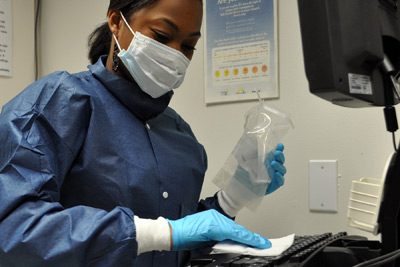Partnership aims to halt bacterial infections in hospitals, clinics
 Cases of people stricken with Clostridium Difficile, a germ that causes fever, nausea and diarrhea, are on the rise in North Texas.
Cases of people stricken with Clostridium Difficile, a germ that causes fever, nausea and diarrhea, are on the rise in North Texas.
Because the illness most often occurs in people taking antibiotics, UNT Health Science Center and the Dallas-Fort Worth Hospital Council Foundation have launched a project to help halt infections where they seem likely to occur – hospitals, local and rural primary care clinics, and long-term care facilities.
Health Science Center personnel will test for the bacteria by collecting environmental samples from about 30 hospitals and health care clinics in North Texas. Samples will be collected from bed rails, bathroom fixtures and other surfaces.
In addition to the environmental study, the DFW Hospital Council Foundation will offer participating hospitals and clinics an education and awareness program that demonstrates how medical workers and the public can avoid infections, such as best cleaning practices.
Incidents of Clostridium Difficile, also known as C. diff, have increased in North Texas from 6.99 of 1,000 acute patient discharges in 2010 to 9.51 of 1,000 in 2014, according to the Foundation. Elderly people and those with certain medical conditions are most likely to get infected.
“C-Diff can cause debilitating illness in infected patients,” said Dr. Kimberly Fulda, DrPH, Assistant Professor of Family Medicine. “This collaboration will help determine how commonly the bacteria are found in health care settings and improve awareness of how we can prevent it.”
The work is funded by a $236,000 grant from the DFW Hospital Council Foundation.
The environmental samples are being collected by the North Texas Primary Care Practice-Based Research Network (NorTex) within the UNTHSC Texas Prevention Institute. Dr. Joon Lee, PhD, Assistant Professor of Environmental and Occupation Health, and Dr. Jerry Simecka, PhD, Professor of Cell Biology and Immunology, are providing expertise and overseeing the collection and processing of the samples in this multidisciplinary project.






Social media